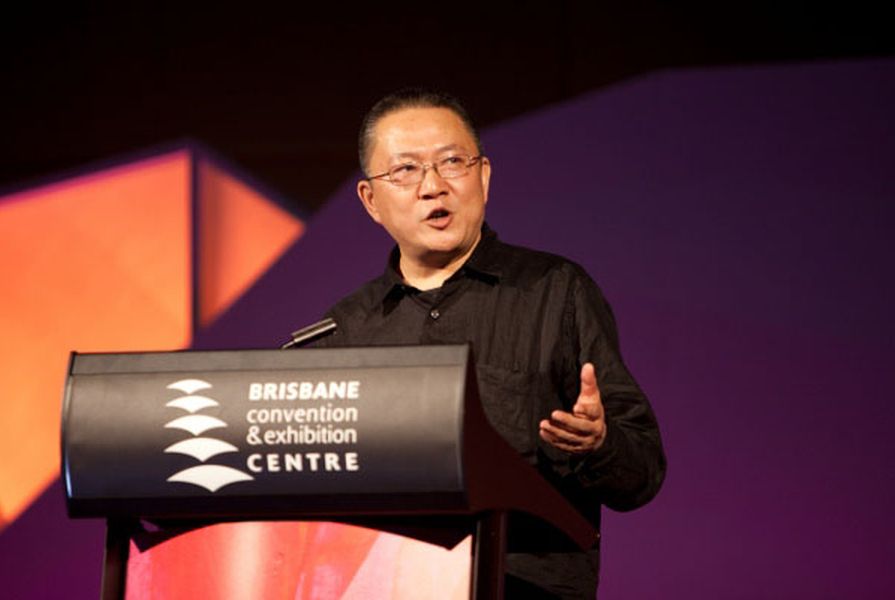Breaking the pattern of the continual baton change between Sydney and Melbourne, this year’s National Architecture Conference was held in Brisbane for the first time in eighteen years. I was a second-year university student the last time the conference was held in Brisbane, and still carry with me the joyous memory of the wonderfully irreverent Ian Athfield and his slightly lewd descriptions of his projects and their procurement processes. I also have distinct memories of local boy Russell Hall presenting his work in this international forum for the first time, proudly parading in the open-neck Daniel Boon-styled tasselled shirt that his sister had made for him. Such is the visceral power of attending conferences, and experiencing the description and discussion of architecture first-hand.
There is a certain leap of faith involved in inviting speakers to conferences. The ideal combination of interesting work and an engaging presenter is not necessarily a given. It’s always a delight for both the curating directors and the audience when the conference theme is interpreted laterally and used as a framework for the speakers to critically reflect on their work. This year, the simplicity of the one-word theme of “experience” reflected the Queensland preoccupation with habitation, tectonics and phenomenology, rather than digital systems, iconic forms and semantic or symbolic meaning.
Rachel Neeson.
Image: Ethan Rohloff
Rachel Neeson set the stage wonderfully for this discussion with a presentation of the work of Neeson Murcutt through a series of lenses – setting, occupation, palette – articulating a very clear framework that demonstrated the reflexive nature of practice. This allowed for the comparative discussion of projects in relation to broader ideas, establishing a series of ideas or themes that were then demonstrated through a range of projects of various scales and stages of completion.
Following suit, Kathryn Findlay beautifully illustrated the curatorial intention to shift the discussion of architecture beyond the visual by beginning with a description of lingering, memorable experiences created more viscerally, by the senses of smell and sound punctuating time and space. The joy of Findlay’s work lies not only in the sensuous and tactile quality of buildings, but is also influenced by enjoyment in the broader experience of procurement that she describes as “getting pleasure out of analysing practical info, assembling this and giving it back to the client.”
On Saturday morning, three wonderful presentations in a row nudged us all out of the haze that had resulted from the “fringe experience” of the social events of the evening before. Luis Feduchi’s selection of a single project, the Carmen del Negro Historic Archives of Granada, which is currently under construction in the Albaicín, was layered with a series of complex and detailed ideas that resounded at a range of scales.
Anuradha Mathur and Dilip da Cunha complemented this beautifully, entrancing the audience with the logic of their argument and the inventiveness of their mapping and rendering technique, which seemed to be all the more provocative and visceral for its ambiguity. However, an informal survey of opinion revealed that some delegates found the ideas about the shifting landscape as a ground for architecture a little obtuse. This strong, if uneven, division of the audience marked it as an excellent presentation. Being not about individual buildings, but about the act of building, it left us with the unforgettable idea that floods are designed disasters, not natural ones.
Following these two excellent presentations, the almost endless breadth and depth of Peter Rich’s work in Africa highlighted the theme of “learnt in translation,” emphasizing the dynamic engagement with culture as central to architectural production. Collectively these three presentations evoked the gamut of old/new, large/small, civic/cultural, temporal/permanent and all the myriad positions in between.
Wang Shu’s presentation embodied all of these things, and was a fitting keynote to the conference. It offered an insight into an impressive range of projects and ideas that are otherwise very difficult to access due to both the location of this work and his very recent international recognition as the 2012 Pritzker Prize winner. Similarly, the smooth presentation by Snøhetta’s Kjetil Thorsen, skilfully moderated by Brit Andresen, reminded us that research, not just experience, is central to intuition. This provided the perfect end to a very interesting two days.
Two significant events were squeezed into the lunch breaks. The first was the celebration of two local publications, Naomi Stead’s Semi-Detached: Writing, Representation and Criticism in Architecture and Robert Riddel’s much-anticipated Robin Dods: Selected Works, both published by Uro Media. The second was the launch of the Parlour website, a fantastic initiative that will have an enormous effect on the practice and experience of architecture in generations to follow.
Hats off to the creative directors Michael Rayner, Peter Skinner and Shane Thompson for a stimulating program that was complemented by the great atmosphere of high school reunions in between presentations, as old friends were reunited and new acquaintances were forged. This was reinforced by a range of fringe events, including a couple of fantastic parties, a few great bar tours and several site visits to a range of projects both in Brisbane and on the Sunshine and Gold Coasts.




















